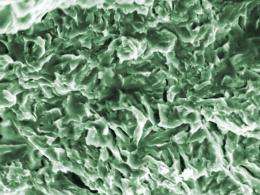Scanning electron microscope images of a test section of X100 alloy pipeline steel shows the effects of a hydrogen-induced crack at the surface. Image shows an area roughly 21.5 micrometers across. Color added for clarity. Credit: National Institute of Standards and Technology
(Phys.org) -- Researchers at the National Institute of Standards and Technology (NIST) have published their first archival paper based on data from the institute’s new hydrogen test facility. The paper examines the embrittling effect of pressurized hydrogen gas on three different types of pipeline steel, an important factor for the design of future hydrogen transportation and delivery systems.
The research team’s initial measurements largely confirmed prior work—though it also extends those measurements to a new steel alloy. More importantly, they say, the work lays the foundation for their primary project, determining the largely unexamined effect of how hydrogen gas combined with fatigue reduces the service life of pipelines.
Under certain conditions, the effects of hydrogen on steel alloys are fairly well known. It can attack minute surface cracks in the alloy and eventually make it more brittle. High-pressure natural gas or petroleum pipelines are subject to attack by small amounts of hydrogen, but the effect is usually negligible and the oil and gas industry deals with this. But what about pressurized hydrogen gas in similar pipes—the sort you’d need in a transportation and distribution system for hydrogen fuel cell vehicles or home energy units? The new NIST facility, the largest in the United States, is designed to answer questions like that.
The current results, according to NIST materials research engineer Andrew Slifka, demonstrated “classic embrittlement phenomenon—as the strength of steel goes up, the influence of embrittlement also goes up.” The NIST tests were new in that they showed the effect with pressurized gas and extended the data to include X100, a modern high-strength steel alloy not yet used in the United States. The experiments tested tensile strength, essentially pulling on test specimens past the “yield” point, the strain under which the metal stops snapping back like a spring and starts stretching like taffy. They showed that the embrittlement effect of the gas starts playing a role at the yield point, according to Slifka, and upon reaching the tensile strength of the material, surface cracks initiate and grow.
Slifka says the results are a useful baseline, but “no one runs pipelines at the yield point. The real question is will fatigue testing show the same results?” Fatigue, the action of repeatedly stressing and relaxing the metal, much better reflects the daily usage of gas pipelines, says Slifka, but there is relatively little data on its effect on hydrogen embrittlement, especially for a hydrogen gas line. The main focus of the NIST facility is gathering that data.
Studying fatigue effects is necessarily a time-consuming process, but now less so. The NIST team has developed a clever linkage system that allows them to chain several test specimens together and test them simultaneously while still gathering independent data for each one. With conventional test methods, a typical test run for a single sample can take two to three weeks. In the same amount of time, the new testing apparatus can generate an amount of data that used to take over six months to collect.
More information: www.nist.gov/mml/materials_rel … -pipeline-safety.cfm
N.E. Nanninga, Comparison of hydrogen embrittlement in three pipeline steels in high pressure gaseous hydrogen environments. Corrosion Science 59 (2012) 1–9. DOI:10.1016/j.corsci.2012.01.028
Provided by National Institute of Standards and Technology






















